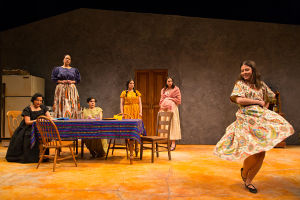| The Women of Padilla
Through April 30 at Two River Theater, Bridge Ave., Red Bank
NJ. Performances Wed. at 1PM & 7PM; Thurs at 10AM & 8PM; Fri.
at 8; Sat. at 3 & 8; Sun. at 3PM. For tickets ($40-$70): www.tworivertheater.org
or 732-345-1400
If ever a play was suited for Two River’s intimate
black-box Huber theater, it is “Padilla,” but Tony Meneses’
75-minute play about eight women waiting at home while their husbands
are away at war is being staged in Two River’s 350-seat main
auditorium, a veritable arena by comparison. On the page, each woman
is distinctly drawn both individually and in relation to the others.
In brief, often clipped exchanges (most speeches are one or two sentences),
Meneses exposes the women’s close-to-the-surface emotions with
clarity and urgency. On the wide stage those elements are diffused;
the words are there (and the performances are fine), but there’s
little tension.
While there is a Padilla municipality in Mexico (thanks, Google),
the title refers not to a location, but to a shared surname, acquired
by the eight women when each married one of eight Padilla brothers,
all of whom are at arms in an unspecified war (“It’s just
men and bloodshed; it doesn’t matter where”). The sisters-in-law
are thus linked by marriage, but more so by longings for their husbands
and fears for their well-being. In the course of the play they tease,
bicker, gossip (best not be the absentee) and support one another.
They also commiserate as the ravages of war come home to roost –
literally. Well, symbolically literally, if you’ll allow a seeming
contradiction. Word of battlefield casualties arrives via swooping
birds that drop written-name notes and then fly away. Represented
as large, stylized messenger pigeons, they inspire dread among the
women (and some inexplicable titters from the audience).
Written by a man, the play emanates an acute sense of its women’s
values, emotions and some quirky wit: “We’re out of oregano,”
one says. “Here,” another pulls from her pocket. “You
carry oregano with you?” “Yes, let me know if you need
anything else.” There are also more than a few heart-stoppers:
“…I imagined my own touch was his.”
Each woman is identified by a particular characteristic: there’s
Carmen (Jeanine Serralles), the one who drinks (and gets laughs);
Mari (Jacqueline Correa), who quietly leads (and who imagined that
touch); Marta (Keren Lugo), the one with faith, who prays through
a hole in her roof (“The bucket’s for the rain”)
and Alejandra (Paloma Guzmán), the one who’s ‘expecting’
(an unnecessary euphemism – even in rural Mexico) and whose
pigeon-note is shattering.
Cristina (Elizabeth Ramos), the one who’s young, is 16, as is
her husband, who didn’t want to be the only bro with no one
waiting at home; Fidela (Daniella De Jesús) is the one who’s
taciturn (but travels with oregano); Lucha (Helen Cespedes), the one
with poetry, caps the play with signs of hope. Last but not least
is Blanca (Karina Arroyave), the one on the outside. She’s housework
challenged (“I lack a critical eye when it comes to cleaning”),
but it is to her that Mari opens up in an emotionally written and
acted two-scene: “How do you do it?” Mari asks her. “The
birds won’t stop. How do you do this by yourself?” “I’m
miserable,” Blanca replies. “I sit here, every day, drowning
in this house, drowning in my own despair.” (Cue break from
reading for a sip of tea and a tissue.)
That the production does not fulfill the play’s potential is
certainly not the fault of the eight-actor ensemble (each of whom,
strangely enough, projects the Padillo boys’ strikingly similar
taste in women) or, for that matter, of any one individual. While
director Ken Rus Schmoll shoulda/coulda tightened up the staging and
brought the women closer together physically and other-ly, he’s
not helped by designer Arnulfo Maldonado’s set or furnishings
or props, which barely indicate in whose houses each of the ten scenes
take place. (It’s clear in the text, but much of the matching
dialogue is lost to a lack of vocal projection.) Rather, it is the
overall conception that diminishes the play.
During my reading of “The Women of Padilla” I took a few
breaks just to prolong the experience; no such impulse occurred during
its opening night performance.
|


